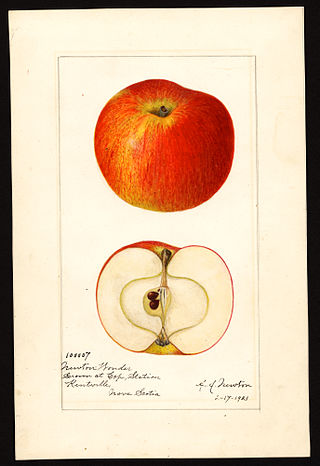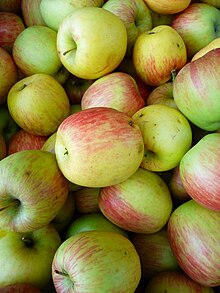
The Royal Horticultural Society (RHS), founded in 1804 as the Horticultural Society of London, is the UK's leading gardening charity.

Malus is a genus of about 32–57 species of small deciduous trees or shrubs in the family Rosaceae, including the domesticated orchard apple, crab apples and wild apples.

Sorbus is a genus of over 100 species of trees and shrubs in the rose family, Rosaceae. Species of Sorbus (s.l.) are commonly known as whitebeam, rowan, mountain-ash and service tree. The exact number of species is disputed depending on the circumscription of the genus, and also due to the number of apomictic microspecies, which some treat as distinct species, but others group in a smaller number of variable species. Recent treatments classify Sorbus in a narrower sense to include only the pinnate leaved species of subgenus Sorbus, raising several of the other subgenera to generic rank.

Malus domestica is an English cultivar of apple that is usually eaten cooked due to its sourness. The variety comes from a pip planted by Mary Ann Brailsford. The Concise Household Encyclopedia states, "Some people eat this apple raw in order to cleanse the palate, but Bramley's seedling is essentially the fruit for tart, pie, or dumpling." Once cooked, however, it has a lighter flavour. A peculiarity of the variety is that when cooked it becomes golden and fluffy.

The Award of Garden Merit (AGM) is a long-established annual award for plants by the British Royal Horticultural Society (RHS). It is based on assessment of the plants' performance under UK growing conditions.

Malus floribunda, common name Japanese flowering crabapple, Japanese crab, purple chokeberry, or showy crabapple, originates from Japan and East Asia. It may be a hybrid of M. toringo with M. baccata, in which case it would be written as Malus × floribunda.

Golden Noble is an old English cultivar of domesticated apple, which is especially used as a cooking apple, since it is resulting in a sweetish puree when cooked and is a good choice for apple sauce.

The 'Laxton's Superb' is an apple cultivar that was developed in England in 1897. It is a cross breed between 'Cellini' and 'Cox's Orange Pippin'. It is a British apple with a green color and a dull red flush. It is a firm-textured dessert apple. The fruit is well known for its sweet and aromatic taste, which is likened to the parent cultivar it is derived from, the 'Cox's Orange Pippin'.

Malus domestica Newton Wonder is a cultivar of apple which is usually eaten cooked due to its sourness. The variety has a similar but slightly sweeter taste than the Bramley apple and is usually used in pies or as a preserve.

The 'Sunset' is an apple cultivar derived from the Cox's Orange Pippin cultivar. Both are found in Great Britain. The fruit has red stripes and an orange flush over a gold background. Usually, part of the apple is red while part of it is yellow. It is similar to 'Cox's Orange Pippin' in that it displays some russetting. The 'Pixie' apple is a distant descendant.

Malus PERPETU 'Evereste' is an ornamental cultivar of crabapple that was developed by INRA in 1974 and is registered under their trademark with the name Malus perpetu.

'Worcester Pearmain' is an early season English cultivar of domesticated apple, that was developed in Worcester, England, by a Mr. Hale of Swanpool in 1874. It was once the most popular cultivar in England for early autumn harvest and is still popular to keep in the garden. It has been extensively used in apple breeding.

'Alkmene' is a German cultivar of domesticated apple, also called 'Early Windsor'.

'Ellison's Orange' is an English cultivar of domesticated apple, it is a cross between the 'Cox's Orange Pippin' and 'Cellini', which it resembles most in looks and taste, but can develop a distinct aniseed flavor in storage. The variety is much more disease-resistant than Cox's and therefore easier to cultivate.

Winston is an English cultivar of domesticated apple which was first named Winter King because of its availability in the winter, but was renamed as Winston in 1944 or in 1945, after Winston Churchill.

Grenadier is an English cultivar of domesticated apple mainly used for cooking. It originated in the mid-19th century in Buckinghamshire. It was first recorded in 1862 in Maidstone, Kent, exhibited by Charles Turner of Slough, Berkshire, and then commercially introduced by Bunyard Nursery.
Hugh Ermen (1928–2009) was a British horticulturalist,. considered one of the United Kingdom's leading amateur apple breeders. He specialised in breeding new apple varieties, especially own root trees, and was awarded the Royal Horticultural Society Associate of Honour in 1988 for his contributions to pomology.
Isabella Preston was a horticulturist and public servant widely recognized for her achievements in plant hybridization and extensive work in ornamental plant breeding. She is Canada’s first female professional plant breeder. During her 26-year career, she produced nearly 200 new hardy hybrids of lily, lilac, crab apple, iris and rose plants for Canada's cold climate. While female plant breeders were rather rare in her day, she quietly challenged gender bias and set the stage for new generations of breeding programs at the Central Experimental Farm in Ottawa, Ontario, Canada and elsewhere.

Malus × robusta, called Siberian crab apple along with other members of its genus, is a hybrid species of flowering plant in the family Rosaceae. It is the result of a cross between Malus baccata and Malus prunifolia. It is being studied for its resistance potential to fire blight. Known for its attractive fruit that remain on the tree well into winter, its cultivar 'Red Sentinel' has gained the Royal Horticultural Society's Award of Garden Merit as an ornamental.

The Wagener is a cultivar of the domesticated apple. It was first farmed in 1791 in New York, and is the parent of the Idared and, possibly, the Northern Spy. Despite the early popularity of the Wagener, it is no longer widely grown.


















